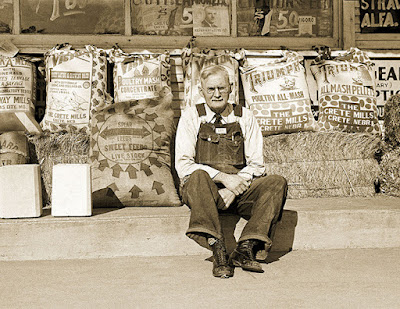In 1938 photographer John Vachon (1914-1975) came to Kansas to take pictures of farmers and their lives for the Farm Security Administration. He recorded this man in Topeka sitting among some of what looked to me like polka dot feed sacks.
"I didn't know it at the time, but I was having a last look at America as it used to be." John Vachon
The photos are wonderful in themselves and the Kansas history is interesting, but I liked the pair of pictures because they seemed to show dress print sacks in photos dated 1938, adding to evidence of a late-1930s date for the advent of these fabric containers. See a post on the 1938 invention:
https://barbarabrackman.blogspot.com/2022/04/milestones-in-textile-history-richard.html
But I am not knowledgeable about the subtleties of commodity containers. Gloria Nixon is one of the top authorities. She commented on the Rees photo:
"I feel those aren't dress prints. [See] Crete Mills/Victor Feed letterhead from 1930 and 1934 showing some of its bags. Now look at the Jack Rees photo. From the little I've found, Crete Mills used a motif corresponding to the feed the bag held: pigs, chicks, eggs, etc., throughout the 1930s. Victor Flour is the product I would expect to see packaged in pretty dress prints around 1938."
I guess what I thought was a polka dot is an egg. I opined that the piggy print would make a cute child's garment. But sez Gloria....
"The labels took up most of the cloth anyway, front and back. There would be little fabric to use for anything."
So Mr. Rees is indeed selling feedsacks but not the kind with the dress prints that we are so familiar with. The Victor feed containers predate the usual dress print sacks. And that's why the Facebook groups are so useful---group think. Fine points discussed. Experts chiming in.








I knew women in my quilt guild in rural South Carolina who wore feed sack clothing as children. One recalled as a teenager trying to persuade her father to buy two sacks of the same pattern when he went to town so she could make a dress.
ReplyDeleteIn reply to the comment about the label taking up most of the sack, I’ve seen sacks where the label is a sheet of paper pasted onto the fabric sack. So the label could be removed by soaking it in water. I’ve also seen plain white sacks with printed labels used as quilt backs.
ReplyDelete